一、编译环境
myeclipse2017、python3.7.0
二、程序分析
(1)读文件到缓冲区(process_file(dst))
1 def process_file(dst): # 读文件到缓冲区 2 try: # 打开文件 3 file = open(dst, 'r') # dst为文本的目录路径 4 except IOError as s: 5 print(s) 6 return None 7 try: # 读文件到缓冲区 8 bvffer = file.read() 9 except: 10 print("Read File Error!") 11 return None 12 file.close() 13 return bvffer
(2)处理缓冲区 bvffer代码,统计每个单词的频率,存放在字典word_freq(process_buffer(bvffer))
1 def process_buffer(bvffer): # 处理缓冲区,返回存放每个单词频率的字典word_freq 2 if bvffer: 3 # 下面添加处理缓冲区bvffer代码,统计每个单词的频率,存放在字典word_freq 4 word_freq = {} 5 # 将文本内容都改为小写 6 bvffer = bvffer.lower() 7 #去除文本中的中英文标点符号 8 for ch in '“‘!;,.?”': 9 bvffer = bvffer.replace(ch, " ") 10 # strip()删除空白符(包括'/n', '/r','/t');split()以空格分割字符串 11 words = bvffer.strip().split() 12 for word in words: 13 word_freq[word] = word_freq.get(word, 0) + 1 14 return word_freq
(3)输出 Top 10 的单词(output_result(word_freq))
1 def output_result(word_freq): #按照单词的频数排序,输出前十的单词 2 if word_freq: 3 sorted_word_freq = sorted(word_freq.items(), key=lambda v: v[1], reverse=True) 4 for item in sorted_word_freq[:10]: # 输出 Top 10 的单词 5 print("单词:%s 频数:%d " % (item[0], item[1]))
(4)主函数(main())
1 if __name__ == "__main__": 2 import argparse 3 dst = "F:\Python\Gone_with_the_wind.txt" 4 5 bvffer = process_file(dst) 6 word_freq = process_buffer(bvffer) 7 output_result(word_freq)
三、代码风格说明
(1)import语句应该分行书写
1 import cProfile 2 import pstats
(2)使用4个空格进行缩进
1 def process_file(dst): 2 try: 3 file = open(dst, 'r')
(3)每行代码尽量不超过80个字符
四、程序运行命令、运行结果截图
(1)编写完成word_freq.py,在DOS窗口执行
《Gone_with_the_wind》:
运行命令:python word_freq.py Gone_with_the_wind.txt
运行截图:
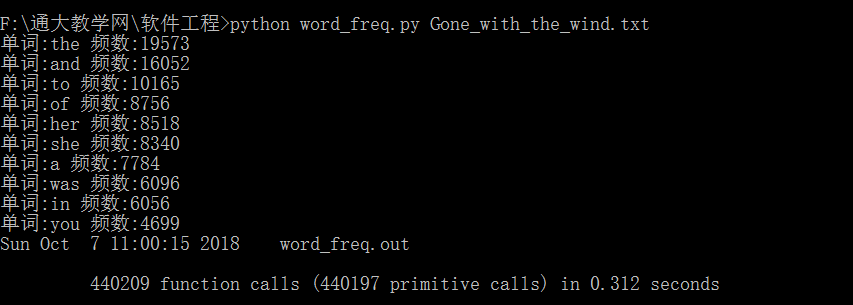
《A_Tale_of_Two_Cities》
运行命令:python word_freq.py A_Tale_of_Two_Cities.txt
运行截图:
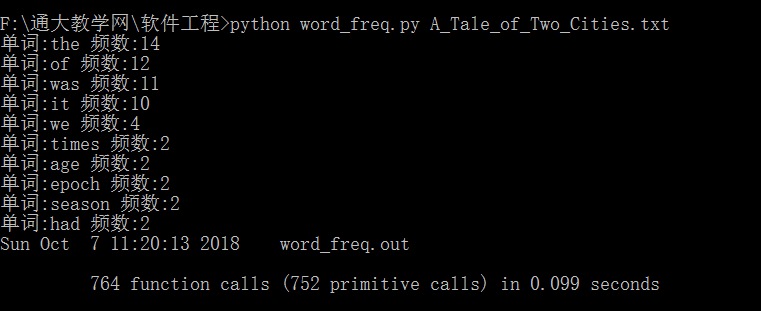
(2)在myeclipse2017中直接运行
《Gone_with_the_wind》

《A_Tale_of_Two_Cities》
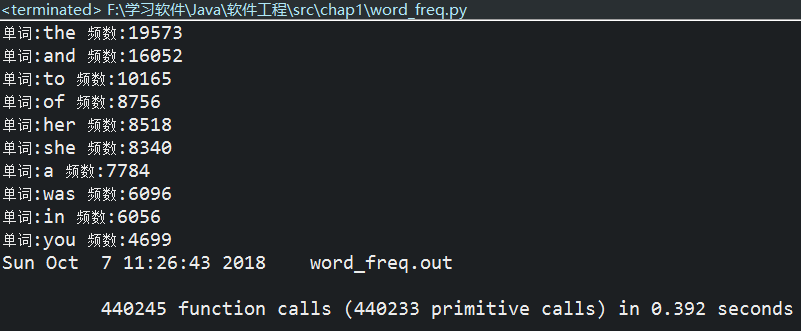
五、性能分析及结果改进
附:ncalls:表示函数调用的次数; tottime:表示指定函数的总的运行时间,除掉函数中调用子函数的运行时间;
percall:(第一个percall)等于 tottime/ncalls; cumtime:表示该函数及其所有子函数的调用运行的时间;
percall:(第二个percall)即函数运行一次的平均时间,等于 cumtime/ncalls;
filename:lineno(function):每个函数调用的具体信息;
(1)执行时间最长的代码
1 for ch in 'ABCDEFGHIJKLMNOPQRSTUVWXYZ':
bvffer = bvffer.lower()

(2)执行次数最多的代码
1 for word in words: 2 word_freq[word] = word_freq.get(word, 0) + 1

(3)使用 cProfile 进行性能分析
统计《飘》-Gone with the wind 的词频:
1 python -m cProfile word_freq.py Gone_with_the_wind.txt | grep word_freq.py
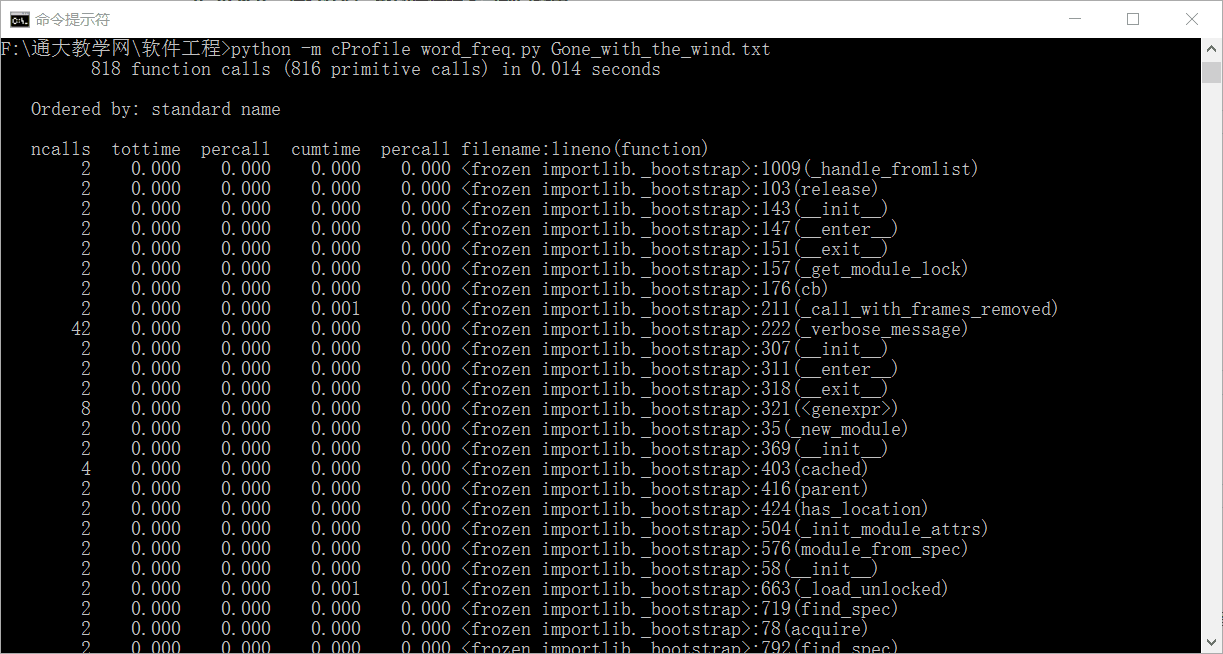
(4)可视化操作
工具:graphviz,gprof2dot
对word_freq.out进行可视化操作:
1 F:\通大教学网\软件工程>python -m cProfile -o result.out -s cumulative word_freq.py Gone_with_the_wind.txt 2 F:\通大教学网\软件工程>python gprof2dot.py -f pstats result.out | dot -Tpng -o result.png
转换得到图如下:
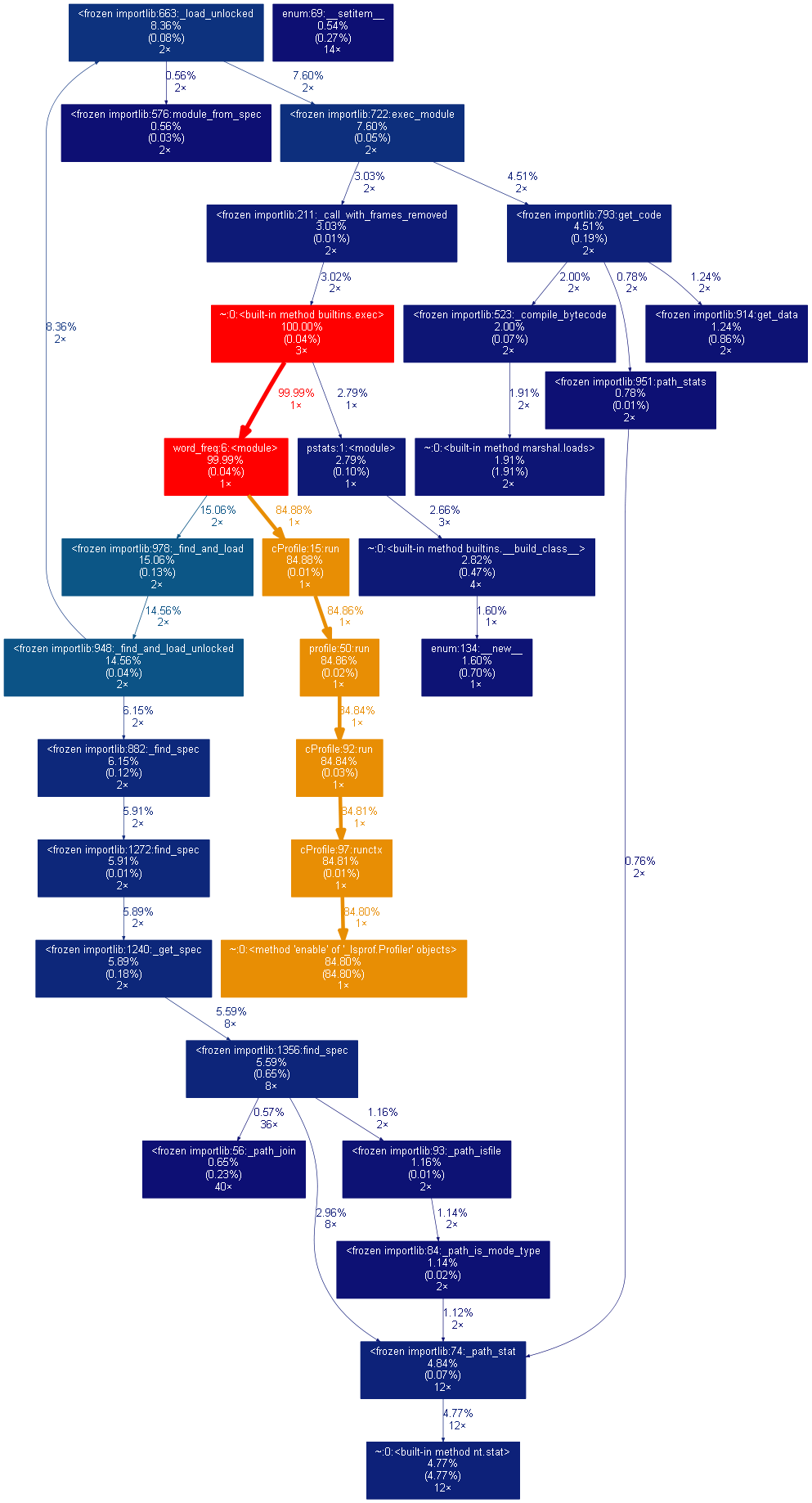
(5)改进代码
分析:通过减少函数调用次数、优化算法的方式来改进代码。
实现:通过减少函数对字母大小写的判断次数来节省时间。
原来的代码:
1 for ch in 'ABCDEFGHIJKLMNOPQRSTUVWXYZ': 2 bvffer = bvffer.lower()
改进后的代码:
1 bvffer = bvffer.lower()
对比:
原来的代码运行结果:

改进后的代码运行结果:

结论:通过结果分析发现改进后的代码比改进前的代码运行时间减少了1.903s